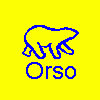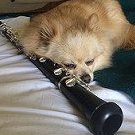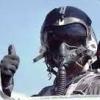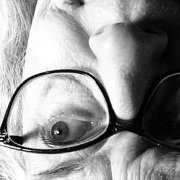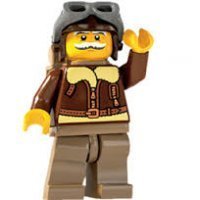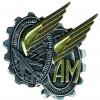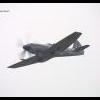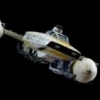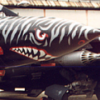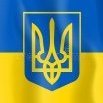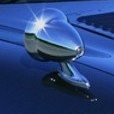Search the Community
Showing results for tags 'Civilian'.
-
As this is the wrong scale for me as I want 1/600 for liners it might seem stupid to buy this kit when there are a 1/600 scale Titanic from Academy. But as I have a saw this kit is just what I need to build RMS Aquitania in 1/600. First I remove 10,3 mm from the hull. After the hull has been put together again more parts were removed. Now I have a hull that has the dimensions wanted. As Aquitania had four propellers while Titanic had three work has to be done to the stern. A piece of thick plastic card was cut and bent in to shape. Glued in to place gives a deeper rear. A piece of the bottom has been removed. The paper rudder is just there to help me at the next stage of the rebuild.
-
This is the 2nd time I've made the Airfix 1/48 Mk XIV, the first was over 4 years ago and my return to modelling after 30+ years away. Anyway, it wasn't any easier 2nd time around..... though its an enjoyable model to construct and goes together quite well I had a couple of problems with filling the camera ports behind the cockpit (will try a different filler next time), and with the canopy fit. This was not a problem when I made the first one 4 years ago so wondering what's going on, but the rear bubble canopy section just did not fit at all properly and I didn't find out until after I had painted, applied the yellow dashed line decal and varnished it! Luckily the spare canopy from the previous model was a better fit but still not perfect. But sadly it means I'm missing that specific decal..... and I don't have enough posts for a wanted advert yet. 😢 Anyway here it is... lots of learnings about filler and sanding to remove seam lines, should have attached gun barrels before painting, and also spraying gloss paint is not nearly as straightforward as it seems - on close inspection its very orange-peely but again I think I know what I have to do for next time. And Red seems to stay sticky for a very long time! Primed with Vallejo Black then light grey (had to balck initially as the seam-filled sections showed up too much under the light gray on its own, then Humbrol Gloss 19 acrylic which is a good paint. I tried a few different Vallejo reds but the Humbrol was the nicest.
- 12 replies
-
- 54
-

-

-

-
We all understand "War is Hell". For starters, we do a lot of GBs focused on it. Some of us (not me) have fought in wars or served in the military, or their friends and family have. Others have suffered as civilians through wars, or their friends and family have. Many of us have studied wars, campaigns, battles, and weaponry. Between that and the news of the day, which seems worse by the hour sometimes, it might be nice to turn our modeling attention to...the opposite of war? The point of war? The place I think most people would want to whole world to get to, and stay at. Let's call it Give Peace a Chance. For this GB, it's pretty easy. Build something that's not a weapon of war, a means of war, or in any meaningful way associated with war. For example: . cars, trucks (civilian ones), trains . airliners, general aviation . ocean liners, cargo ships (not while pressed into war service) . research vessels/planes . civilian spacecraft Anything from anywhere and any-when, just not military. Sure enough there are some grey zones. Search and rescue - that's good - but often flown by the military. If it says Air Force, Navy, Army, Marines on the chopper, maybe not. Disaster relief - often done by the military and also a good thing. Maybe not for this GB. UN - more of a "it's not war while we're standing on this field" but it's not really peace if there's peacekeepers. Former military stuff pressed into civilian service - the "Swords to Ploughshares" idea - if you like but it's probably a bit of a grey zone given how many not-as-military-adjacent options are out there. There's a ton to choose from outside the grey zone, so I'd say try to make a pretty clear choice. 1. me 2. @theplasticsurgeon 3. @zebra 4. @TimJ 5. @Karearea 6. @Heather Kay 7. @Bandsaw Steve 8. @IanC 9. @Grandboof 10. @Corsairfoxfouruncle 11. @rafalbert 12. @Redstaff 13. @John Masters 14. @Mjwomack 15. @ArnoldAmbrose 16. @Marklo 17. @Keeff 18. @2996 Victor 19. @Paul821 20. @Bengalensis 21. @Paul J 22. @Wings unlevel 23. @flashlight 24. @arfa1983 25. @CliffB 26. @Thom216 27. @Ray S 28. @Trevor L 29. @Whofan 30. @Bertie McBoatface 31. @TonyW 32. @RC Boater Bill 33. @Bobby No Mac 34. @robw_uk 35. @wimbledon99 36. @Kanesuke 37. @rob Lyttle 38. 39.
-
I was given this model that had been slightly started. Wing halves had been assembled. Also the filling with windows for the cargo door has been glued. Every planned Ju 52/3m that I have is for a prewar plane where the cargo door has to be replaced and new corrugation has to be built. Now I needed to find a postwar plane with the cargo door. I found one but I had to build a door at the front. I used part of the unused cargo door for this. The Italeri kit has some spots that are missing corrugation. So i made a quick "dirty fix". As this plane isn't one that was on my build list I'm not putting to much work into it. It is now ready to enter the paint box. Hopefully I will manage to scrounge together the decals needed for it.
-
Hello all, I am intending to build the Revell 04478-0389 1/32 kit of the venerable Sud-Aviation SE 3130 Alouette II, but on floats, in civillian livery and markings. The aircraft chosen will be Zulu Kilo Hotel November Whisky (KZ-HNW) registered to Helicopters NZ (HNZ) and has an all-orange airframe with white cabin roof and yellow tail skid. The floats appear in the photo that I have to be white or a very light grey, with dark grey strips. Kit box via Scalemates: The photo of the aircaft can be seen here (via the HelicoptersNZ in the 1970s page from 'Top Birds & Everyfing' on Typepad): Photo copyright Top Birds & Everyfing on Typepad This photo also suggests the basis for a very simple but highly-contrasting diorama. The kit has a relatively large number of parts, (at least compared with the as-yet uncompleted and possibly ill-fated Accursèd Seafire 1/72 kit by Pavla that nearly drove me around the twist in very short order: I have a house brick on standby for that one), even without the bits for the Nord 5210 SS-11 missile system. This kit has been impinging on me off and on for some time now, and this Group Build is the perfect opportunity to do something with it . I have very clear memories from when I were quite small of seeing pictures of Alouette-like helicopters with floats on buzzing about, so I went looking on ye internet, and sure enough, quite a few turned up. The one that leapt out at me was the very attractive (well, to me at any rate) orange, white and yellow HNZ machine. I have read through the instructions (I keep all the kit instructions separate from the kits in my collection - coz I'm weird) and will trundle down to the lockup and attempt to retrieve the kit from the slightly-ordered mound of removalist's boxes that the stored part of my collection lives in, in the next day or so. The floats will be made from fine-celled blue Styrofoam building insulation, which I acquired a few sheets of a while ago for making parts for my flying radio-controlled scale models (last used for cowling scoops for my 1:5 Chippie cowling plug). I still have a lot left. If all goes according to plan I might even be able to float it in the bathtub. So, that's the plan. I also have a Plan B, which involves the Airfix 1/72 Crab Sea King HAR3 helicopter - which needs no introduction to anyone. Another brightly-coloured aircraft, all-yellow this time of course. I'll post again with some snaps once I've dug out the kit. Cheers, Alex. <-- likes the look of the nice grass in that photo above. Being in New Zealand, a sheep probably wouldn't be out of place on the mooted diorama...
- 49 replies
-
- 10
-

-
- Revell 1/32
- civilian
-
(and 1 more)
Tagged with:
-
US 1.5t 4x4 G506 Flatbed Truck (38056) 1:35 MiniArt via Creative Models Ltd The Chevrolet G506 truck formed the basis of a range of 4x4 load-carrying vehicles that were capable of carrying up to 1.5 tonnes of cargo or equipment. They were initially made under the 4100 code, then moved to the 7100 range, and usually had a standard enclosed cab, with a 3.9L straight-6 engine under the bonnet, with a four-speed “crash” (non-syncro) gearbox putting down a little over 80hp through all four axles. Under the new coding it rapidly became the Allies’ standard light truck, and served in substantial quantities with the Allies in the West, the Soviets in the East, and the forces fighting Japan in the Far East. There were a lot of variants, some in US Army service, others in USAAF service, with almost 50,000 of two specific types, the G7107 and G7117 sent over to the Soviets under the Lend/Lease program. The civilian vehicles could be almost as varied in form as the military options with some obvious exceptions (civilians seldom have a need to launch rockets), and they were well-liked by their drivers and crews, carrying out cargo shipping duties before, during and after WWII. They benefitted from widely available spares and the know-how to repair and maintain them, and they served long after the end of WWII. The Kit This is a new boxing of a recent tooling from MiniArt, and is one of a range that is lurking about in your favourite model shop. It’s a full interior kit, with engine, cab and load area all included along with some very nice moulding and detail, particularly in the cab and those chunky tyres. It arrives in one of MiniArt’s medium-sized top-opening boxes, and inside are twenty-one modular sprues in grey styrene, a clear sprue, Photo-Etch (PE) sheet in a card envelope, a wee decal sheet and glossy instruction booklet with colour profiles on the front and rear pages. Construction begins with the ladder chassis, which has leaf-springs fore and aft, cross-braces and rear towing eye fitted to create the structure, then has the fuel tank, PE rear bumper irons folded around a styrene jig, and axles installed, before the brake drums/hubs, battery and external brackets are added to the chassis rails. The transfer box and drive-shaft join the two axles together, and a steering linkage and box are inserted into the front of the chassis, then the engine is built up based on the straight six-cylinder block, with carburettor, dynamo and transmission added, plus the pulleys and fan at the front. The engine and substantial front bumper iron are fitted to the chassis, and at the rear a short additional chassis rail are attached to the frame at the rear behind the fuel tank. The exhaust and its manifold slip into the underside of the chassis from below later on, with linkages and axle brackets fitted to the rails. The crew cab is next, beginning with the firewall and forward sidewalls. The roof and windscreen frame are moulded as one, with a headliner insert and rear-view mirror that are inserted within, and the three-part radiator housing is made to be used later. The firewall and roof are joined with some of the dash pots fixed to the engine side of the firewall, while the doors and their interior cards are assembled with their handles and window winders, plus the clear window glass that can be posed open or closed at your whim. The dashboard inserts into the front bulkhead with seven decals for the instruments and stencils on the glove box. The diagonal foot panel is joined with the firewall and decked out with three foot pedals and the steering wheel on a long column that slides through a hole in front of the pedals. The driver and co-driver share a bench seat that is made up on the floor from back, cushion and a C-shaped surround that fits round the rear of the cab back wall, with small ovalised window and optional PE mesh grille fitted later. The roof and firewall assembly are fitted to the floor, with the doors installed within the frame in the open or closed position. The windscreen is two panes of clear in a styrene frame fitted to the front of the cab open or closed, and below it on the scuttle is a ventilator panel that is posed open or closed later as you like it. The cab and radiator are both placed on the chassis with spacer rods applied, and the engine cowling side panels fit between them with front wing/fender included. The aforementioned windscreen has a pair of PE brackets and styrene wingnuts that are installed either vertically for closed, or at an angle for open, with a scrap diagram showing the correct orientation of the various parts. The spare tyre is placed on a bracket near the exhaust later, and the front of the vehicle has its headlights with clear lenses plus sidelights fitted to the wings, and PE windscreen wipers hung from the top of the frame, then the front grille is built. You may have noticed that this doesn’t appear on the sprues, and there’s a good reason for that. It is constructed completely from PE, and two jigs are included on the sprues to assist with obtaining the correct shape. The lower rail and curved side panels are made up on one jig from a single piece of PE, while the centre panel is folded up on another, then they’re joined together ready to be attached to the front of the engine bay. There are two brackets stretched across the front of the radiator, and another small curved section is added to the left of the grille as it is glued in place with the help of some CA. The hood/bonnet is able to be fitted open or closed with two styles of clasp and in the open option, a PE stay is provided. Two closure clasps are fixed to the sides of the bay too. The load bed floor is a single moulding with a ribbed texture on the underside, a slim rear section with moulded-in reflectors, separate rear lights on PE brackets mounted to the chassis. The shallow sides and taller front are separate frames, and the underside is strengthened by four cross-braces. The load bed is joined to the chassis along with the spare tyre on the left side of the flatbed, then the fuel filler and exhaust are added on PE brackets. It’s time for the rest of the wheels to be made up, with singles at the front, each made from two parts each, and twin wheels at the rear, made up much earlier in the instructions for some reason. Each wheel slips over its respective axle, with the hub projecting through the central hub, with a pair of rear mudflaps behind the back wheels. The kit comes with a stack of ten barrels to be made up of four styles, all of which are made from two halves with end caps that are glued in with the embossed writing on the inside, and adding a separate tap on one end, with some of them having four-part stands so they can be laid down on the load bed. In addition, a civilian driver/loader figure is included on his own sprue, wearing overalls and a baseball cap with turned up brim on his head and work boots – on his feet, of course. He is made up from individual legs, torso, head and arms, plus the cap, which is separate so you can replace it with something else if you feel the urge. A top-hat or pineapple maybe? Markings There are five colourful markings options on the decal sheet from various eras of the types operation. From the box you can build one of the following: Indiana USA, 1940s Texas USA, 1945 Florida USA, 1940s New York USA, 1950 Philippines, 1946 Decals are printed by MiniArt’s usual partners Decograph, which is a guarantee of good registration, sharpness and colour density, with a thin matt carrier film cut close to the printed areas. Conclusion We seem to be blessed with new kits of the Chevrolet G506/G7107 truck in 1:35 recently, which was ubiquitous during WWII at home, lugging goods of all types around the USA and beyond. Highly recommended. Review sample courtesy of
-
German & French Traffic Signs 1930-40s (35633 & 35645) 1:35 MiniArt via Creative Models Ltd MiniArt have been creating a range of military and martial signs for your dioramas, and have now moved on to make sets for the general populous during the 1930s and 1940s that aren’t related to the war. Speed limits, warning signs and distance markers that were there before the soldiers came, although some of the direction and distance signs would have been removed as the enemy advanced, but people still needed a clue how fast they can drive and whether they needed to give way at the next junction. These sets arrive in shrink-wrapped figure boxes with a painting of the contents on the front and brief instructions on the rear. There are six sprues in grey styrene in the German box and seven in the French box, plus a decal sheet on blue paper in each that contains all the painted descriptive fronts of the signs. Each sign is metal, and some of the larger signs are also made from a few sections, with the joins and fasteners are visible at the rear. There are plenty of decals on the sheets, so many options that could be spread over multiple dioramas. A few alterations are called out on the back of the boxes, with the German set removing the decorative ball from the top of some of the poles and giving instructions how to install multiple bracketed signs on one post. The French and German signs have a few smaller placards merged with the main sign that have the route or sign numbers on them, which are removed from all the French signs, but left in situ for some of the German signs. Their bases differ too, with the French having a fluted rectangular shape, while the Germans have tapering cylindrical footings. German Traffic Signs 1930-40s (35633) French Traffic Signs 1930-40s (35645) Conclusion Dioramas rely on the minutiae of the background to give a "lived in" look to the terrain, and signage is essential for all but the straightest of roads. The painting guide calls out suggested colours and the minor adjustments to some of the signs as well as how to build up the bases. Highly recommended. Review sample courtesy of
-
I started this in the Nordic GB but got big problems with the fuselage joints so it didn't get finished. I restart the thread here instead. The group build made me dig this one out of the stash. But as usual, building out of the box isn't for me. First, I need to fill all of the small round windows. For this I will need lots of 5,5 mm plastic discs and found that a paper punch will make them, but it is hard to make them without wasting lots of plastic card. A piece of cardboard was used in helping to steer thin plastic strips to minimise the waste. The result was a bag of plastic discs. and holes. I noticed on the text moulded in the wing that this kit is 60 years old this year. I glued in the clear windows and covered them with the plastic discs to get them in level with the fuselage and now it is time to sand them down. Too bad that it will destroy the surface details. I like the very small rivets on it. Started to make holes for new windows
-
In the club we had a Fokker challenge. Build the Eduard 1/48 Fokker DR1. I don't build in 1/48 but I got myself an Revell boxing of the kit and dived in to the unknown. This plane was used by DLR in mail runs between January 1919 and February 1923 but for some reason it didn't get scrapped with the rest of the warplanes after the Versailles treaty. 28/17 was displayed at the Deutsches Luftfahrt Museum in the 1930's. Now repainted to look like Manfred von Richthofen's plane. It was later used in the 1938 movie Pour le Mérite and it is rumoured that it had crashed sometime after the movie. I normally stay away from this scale, but I found that WW1 planes in this scale are rather nice. As I was building it without weapons I needed to build to build a simple fuel tank as it was visible with the guns gone.
-
I stumbled upon this photo collection entirely by accident, and I recall that @Moa and a few others had a WIP and lengthy discussion on Norsemen with wheels, floats, or skis, so I thought some of these photos might be new or useful for modeling projects. What a variety of schemes and fits, and a couple of very nice closeup detail photos! Enjoy! Mike https://www.bing.com/images/search?view=detailV2&ccid=0BpyA5Pp&id=7453481BFC711AC22B0798AB7DD80E3EA6B90485&thid=OIP.0BpyA5PpU6zwA5AOiAEDXQHaF3&mediaurl=http%3A%2F%2Fwww.norsemanhistory.ca%2FPhotos%2FCN190.jpg&exph=507&expw=640&q=Noorduyn+Norseman+Cockpit&simid=607986817709638447&ck=AC0C10AAB9C21CD846203672EA7086B3&selectedindex=254&form=IRPRST&ajaxhist=0&vt=0&sim=11
-
Bit of a weird one here. I've been cataloguing my loft insulation - a surprisingly arduous task. I came across six 'kits', for the want of a better word. Small little beasties, more or less snap together, moulded in bright green plastic. The only identification on them are 'Telegraph magazine' and 'Ford'. Me thinks these were a give away with the Telegraph magazine. One of the vehicles is definitely a Ford Capri - a splendid looking car. The other has the word Lotus moulded into it, and is obviously a F1 motor racing car. The final one is, I think, an middle era Ford Mustang; definitely not their early ones or, indeed, the later ones with all the emission stuff making them big and bulky. This is going back a bit....well probably three decades or more...but can anyone shed any more light on these 'kits' - or even remember them. I finally figured which URL to use As requested... Told you it was a weird question. Many thanks, Angus
-
*Record scratch noise You may be thinking, "Hold it right there! This guy isn't a modeler of floaty things! That model doesn't look like its plastic! Hell, we're not even sure if he's a real Yank, or even a person!" And you would be mostly right. I don't typically build floaty things, this model is paper (gasp!) - which I also don't typically build. And I'm only a naturalized Yank with Eastern European roots, so paper modeling is in my blood, To date, I've started several dozen paper models, and finished exactly zero. I used to get Maly Modelarz issues from Poland when I was younger, but most were way too complex for me. In the last couple of years, I have dabbled occasionally in paper, but have always hit some kind of snag along the way. I recently found a paper sensei to help guide me along, and I very quickly learned that a lot of my problems were related to using the wrong adhesives and tools. She also helped me choose a kit that was simple, but would also keep my interest in the long term. You see, even the simplest of these kits are all long term projects because you're not only gluing parts together, you're also fashioning the parts to be glued. And so we come to JSC Paper Models' SS Atlantic Conveyor. The vessel was a container ship launched in 1970, and was relinquished to the Royal Navy during the Falklands War, at which point it was converted into an auxiliary aircraft carrier for harriers and helicopters. It was hit by two Exocet missiles and sank while being towed back to the UK. The JSC kit is a waterline model in 1/400 scale, and includes parts to build the Conveyor in either civilian or military configuration. It also comes with a squadron of harriers, and helicopters, as well as a nice model of the HMS Sheffield. I have a soft spot for merchant and work ships, so I chose to build the civilian version. I also don't find the prospect of folding and rolling itsie-bitsie pieces for a dozen 1/400 scale aircraft the least bit appealing, but that's neither here nor there. But here is the digest version of work from the last week or two. First, the skellington. JSC kits are a bit unique in that most don't have frame parts that need to be backed by heavy card stock to make the skeleton. Instead, they rely on geodetic shapes and the power of physics to give the structure rigidity. Here we are laying down the"keel". Well, it isn't really a keel, since this is a waterline model, but I wanted to sound all maritime right there as you can see, even at 1/400 scale, this model is going to be pretty large. Fast forward a few nights, and we have the nearly completed hull frame. And it looks like its been out drinking.... I was pretty concerned at this point, but was reassured that it was part of the kit design. Also note the "Shoo Gloo" I'm using. Turns out solvent based adhesives work much better on paper models than PVA. Water from the PVA soaks the paper and causes it to become really wavy. This is what ruined all of my previous attempts at paper modeling. Where was I? Oh yeah, the floppy frames are part of the kit design. The kit comes with two decks. The military and civilian versions. The design calls for you to use both, you just choose which one is the under-decking, and which goes on top, depending on the version you build. The underdecking stiffens the frame pretty nicely. Not perfectly, but some of that might be user error. A bit of rolling hills up there. but overall better than all of my previous efforts. Here is the front half of the second deck layer, just dry-fit for now. Evidently, if I do this right, it should come out looking straight. Stay tuned for more, as I learn more. Oh, and if you're interested in seeing the other cool stuff JSC has to offer - here is a link to their well stocked webshop. And Poland's post-office IS shipping out of country once again, so order with confidence. http://sklep.jsc.pl/index.php/
- 13 replies
-
- 18
-

-

-
Here we go, my first in an occasional series of classic airliners, and the first 1/144 kit I've built since I was about 13! Thoroughly enjoyable to build, and took surprisingly longer than I was expecting given the apparent simplicity of the kit. I'd handpaint the silver and spray the grey next time, but it's lessons learned ready for the next one! All comments and advice welcome!
- 19 replies
-
- 32
-

-
- Classic airliner
- Civilian
-
(and 1 more)
Tagged with:
-
I think @Moa is having a good influence on me. Out of all the military types in my stash, I’ve decided to build a civilian plane. It’s also nothing to do with my 1940 obsession, but I thought it would make a nice change. Not that it matters, Best Beloved is some years older than me. When he was still a young chap about town, he made friends with the owner of an Auster Autocrat. We are talking about the swinging sixties, when Best Beloved lived in the outer reaches of East London, also known as Essex, and worked for a firm based in the Medway Towns. To avoid the hack across the Thames, he would occasionally hitch a lift in his friend's plane, and sometimes be allowed to take the controls, though he never held a pilot's licence. Anyway, I am often regaled by his fond memories of times with the Auster. Although we couldn’t find a civilian kit boxing of the type, not a lot was changed from the military versions so we acquired the AZ Model kit at IPMS Telford a couple of years ago. The plan is to build the AOP MkIII in the kit, with adjustments to make the Autocrat Best Beloved remembers. Amazingly, we found two photos of the actual plane, G-AMVN, one each side. Although memory is hazy, we think the plane was finished in aluminium overall, with the serial in blue on the fin and rudder. The black and white photos sort of hint at the wing struts being a different colour as well, probably blue. Sadly, the real Mike Victor November was written off in an accident in the summer of '69 - probably about when Bryan Adams got his first real six-string… Adjustments will include making a second bench seat in the cabin to make it a four-seater, making a new exhaust system as the real plane had a form of muffler fitted, fitting a wind-driven generator to the starboard wing, and a pitot tube to the port wing. Otherwise, aside from paint scheme and lettering, this will be out of the box. I got the Peewit masking set, so that should make things neater. Not a lot to build, aside from the comprehensive cage structure in the cabin. Lots of butt joints for things, though. I guess I’ll need to add metalwork for extra strength. On with the show!
- 76 replies
-
- 19
-

-

-
Had no intentions on doing this little kit just yet. Knocked my coffee over and made a mess all over the bits and bobs. Thought I had better start it then. Looks like it will be an easy kit to build Decals and masks Thanks for stopping by for a look. Stephen
-
Next build once AEC MK1 is ready for paint. Pictures later
-
Howdy folks, this is for now just a slot keeper, I'll add photos as soon as I get the jest of how to post them. Enjoy the group.
-
Greetings everyone! Along with my Airfix Spitfire Prototype, I've recently finished this model of the High Speed Spitfire. I've chosen to model it in it's later form, with the radiator removed and the DeHavilland propeller (mainly because that was the easiest way). The modifications are: - Filled panel lines except on the cowling. - Landing gear legs from the Airfix Mk.I kit (since I needed the Tamiya legs, which don't have gear doors attached, for the Airfix one) - Shortened and rounded wingtips (a suprisingly small amount given how different they look) - Removed radiator and filled the hole - Added fairings at the propeller blade tips from styrene sheet - Canopy from Falcon set - Omitted radio mast - Scratch built tail skid - Masked and painted tail number and stripe The WIP is here, shared with the Airfix kit: And now, here it is! The propeller hub was painted using a Moltow chrome pen. It would be tricky to do a much larger area without getting pen strokes in it, but wow am I happy with how shiny this turned out!!! The distinctive short wings: I'm still tempted to polish the surface again for a more uniform shine and to remove spots. The Airfix gear was very easy to attach, once I thinned down the attachment plug slightly. Thanks for taking a look, I hope you like it. Beggsy.
-
Hello I am joining this Group Build with this training aircraft which is the Boulton Paul Balliol. As I have been seduced by the box art of this recent kit made by Special Hobby, here she is in civilian guise. This airplane was used as a demonstrator. First I started to make the cockpit with the metal and injected parts from the box. The instrument panel was made of a picture behind the metal part Next I painted the cockpit with mainly a very dark grey I glued the cockpit in the starboard fuselage half To be continued... Patrick
- 10 replies
-
- 2
-

-
- 1/72
- Special Hobby
-
(and 1 more)
Tagged with:
-
Well, this morning I shot some spray-can green on the interior bits of my Tiger Moth, so I guess that means that it is officially started. In my wildest fantasies (err, make that relatively tame fantasies...) I'd like to be done by April 2, which is when the next "local" contest is. For normal people that would be simple, but I seldom claim to be normal. My plan is to do a representative civil-paint example- I'll consult the rules to see how faithful I have to be. I'm also aiming to stick as close to "Straight out of the Box" as I can manage, BUT this'll also be my first attempt at rigging a model. I'm anticipating conducting pretty much the whole build through my magnifying desk lamp! To prove that I didn't cheat: bob
- 18 replies
-
- 5
-

-
- 1/72
- Tiger Moth
-
(and 1 more)
Tagged with:
-
Had a question for anyone with greater knowledge than myself. Could a 1/24 scale car be passed off as suitable for a diorama where everything else was 1/35, or is the difference too great? I wanted to create a scene that, while not necessary, could involve a police car for some additional visual interest, and fit the theme. Unfortunately, it seems all model police cars are often 1/24 scale, and there are no 1/35 examples. The only 1/35 vehicles that can pass as civilian seem to be variations of Hilux, which doesn't suit what I'm after all that much. Long story short, I'm aiming (in my mind at least) to create a diorama based on The Division. Cheers. Gaz
-
news from the Aoshima facebook. Link with more photos: https://www.facebook.com/Aoshima.Bunka.Kyozai.English/posts/1072048049472427?notif_t=notify_me_page full list of releases: All Japan model & hobby show announce items - 2015 OCT/NOV/DEC: 4905083014165 [DEC-NEW] 1/24 FD3S RX-7 IV type PATROL CAR JPY 2,800 4905083011690 [DEC-NEW] 1/24 IMPUL 30S (Y31 CIMA) JPY 3,000 4905083011683 [DEC-NEW] 1/24 K-BREAK 18CROWN HYPER ZERO CUSTOM Ver.2 JPY 3,000 4905083010747 [DEC-NEW] 1/24 LAMBORGHINI SESTO ELEMENTO [OVERSEAS EDITION] JPY 4,200 4905083010761 [DEC-NEW] 1/24 LAMBORGHINI SESTO ELEMENTO Detail-Up Parts [OVERSEAS EDITION] JPY 1,800 4905083014172 [DEC-NEW] 1/24 SUBARU SAMBAR FIRE ENGINE JPY 2,800 4905083028544 [DEC-NEW] 1/32 ICHIBANBOSHI FURUSATOTTOKYUUBIN TSUITOU JPY 14,800 4905083010655 [DEC-NEW] 1/350 I..J.N SUBMARINE I-175 JPY 3,600 4905083011423 [DEC-NEW] 1/48 THUNDERBIRD No.4 JPY 4,800 4905083012062 [DEC-NEW] 1/72 CHEMICAL FIRE PUMPER TRUCK (OSAKA MUNICIPAL FIRE DEPARTMENT) JPY 2,500 4905083012079 [DEC-NEW] 1/72 FIRE LADDER TRUCK (OTSU MUNICIPAL FIRE DEPARTMENT) JPY 2,600 4905083017838 [DEC-NEW] ARPEGGIO ARS NOVA 1/700 BATTLESHIP HARUNA FULLHALL TYPE JPY 4,200 4905083017821 [DEC-NEW] ARPEGGIO ARS NOVA 1/700 BATTLESHIP KONGO FULHALL TYPE JPY 4,200 4905083011577 [DEC-NEW] INITIAL D 1/24 RIN HOJYO SKYLINE BNR GT-R(NISSAN) JPY 2,600 4905083011560 [DEC-NEW] INITIAL D 1/24 RYOSUKE TAKAHASHI FC3S RX-7 (MAZDA) HAKONE BATTLE VERSION JPY 2,600 4905083027387 [DEC-NEW] PRE-PAINTED 1/24 LAMBORGHINI AVENTADOR LP700-4 MATTE BLACK (FOR OVERSEAS DISTRIBUTION LIMITED) JPY 5,600 4905083011386 [DEC-NEW] PRE-PAINTED 1/24 LAMBORGHINI AVENTADOR LP700-4 ORANGE PEARL JPY 5,600 4905083011393 [DEC-NEW] PRE-PAINTED 1/24 LAMBORGHINI AVENTADOR LP700-4 WHITE PEARL JPY 5,600 4905083051269 [NOV-NEW] 1/24 LB WALKS HAKOSUKA 4DR JPY 3,200 4905083051276 [NOV-NEW] 1/24 LB WALKS KEN&MARY 4DR 2015 VER JPY 3,200 4905083025864 [NOV-NEW] 1/24 TE71 COROLLA SEDAN 1600GT LATE Ver. JPY 2,000 4905083027332 [NOV-NEW] 1/32 KODAIRA DUMP TRAILER JPY 6,800 4905083051252 [NOV-NEW] 1/32 SHIINA LINE EXPRESS RYOUMAGOU JPY 6,800 4905083010389 [NOV-NEW] 1/700 SUPPLY SHIP MAMIYA&U.S.S SUBMARINE SEALION JPY 3,600 4905083017791 [NOV-NEW] ARPEGGIO ARS NOVA 1/700 BATTLESHIP HIEI FULLHALL TYPE JPY 4,200 4905083017845 [NOV-NEW] ARPEGGIO ARS NOVA 1/700 BATTLESHIP KIRISHIMA FULLHALLTYPE JPY 4,200 4905083012321 [NOV-SPOT] 1/24 AOI OGRE AN-21 AERO BOOST MODE JPY 2,600 4905083005712 [NOV-SPOT] 1/24 AOI OGRE AN-21 CIRCUIT MODE JPY 2,600 4905083005729 [NOV-SPOT] 1/24 NU ASURADAAKF-0/F(2022VE.R) JPY 2,600 4905083007648 [OCT-NEW] 1/12 Honda CB400FOUR JPY 3,200 4905083007662 [OCT-NEW] 1/12 Honda CB400FOUR Photo-Etched Parts&Metal Sticker SET JPY 2,200 4905083008546 [OCT-NEW] 1/24 ROJAM 21 CROWN ATHLETE (TOYOTA) JPY 3,200 4905083008522 [OCT-NEW] 1/24 ROJAM 21 CROWN ROYALSALOON (TOYOTA) JPY 3,200 4905083027325 [OCT-NEW] 1/32 2ND DOKURO MARU JPY 4,800 4905083011430 [OCT-NEW] 1/700 1/700scale BLUESTEEL I-401ARSNOVAMODE JPY 5,900 4905083009758 [OCT-NEW] 1/700 IJN KUNIKAWA MARU JPY 2,800 4905083010303 [OCT-NEW] 1/700 U.S.S AIRCRAFT CARRIER WAS &I.J.N.SUBMARINE I 19 JPY 3,800 4905083010310 [OCT-NEW] 1/700 U.S.S.AIRCRAFT CARRIER WASP PHOTO ETCHED PARTS SET JPY 2,000
-
At long last I have a 'new' desk which although smaller and lacking drawers/cupboards will at least allow a restart after a too-long break. And what dropped through my letterbox this morning but another early suprise...(although mine is rather more crumpled in appearance) The (not so) mighty Mechanical Horse aka Scammell Scarab which using the kit options would build up to this: I see there is a walkaround (yay!) but only one build thread (aww) so it will fit in nicely as being different to the normal 99.9% of kits seen. Now I just need to get bits and pieces sorted in to place before deciding on RAF, RN or civilian scheme (and another excuse to get to Antics searching the paint stands...whilst ignoring the 'wall of plastic' of course:)) One question/request... Google (and Bing) bring up a few pix of models or museum vehicles in military dress but nothing of real vehicles in action. Whilst I'm still umming and erring on my Dinah build I thought it might look good sat next a 50s or 60s Hunter or Gannet or...
-
Ok while having a long boring nightshift I have come up with an idea for a GB which could include almost everyone! A South Latin American GB Ok after lots of requests by everyone.....well Steve anyway, I had a think about this and decided to open it up to the rest of Latin America. This GB will now cover anything and everything South American "of the border", as long as it was used there or built there it’s ok. There should be a bit of something for everybody here with all forms of transport covered, both military and civilian, even the automotive crowd with Dakar bikes/cars/trucks So countries eligible; Argentina Bolivia Brazil Chile Colombia Costa Rica Cuba Dominican Republic Ecuador El Salvador Gaudeloupe Guatemala Guyana Haiti Honduras Mexico Nicaragua Panama Paraguay Peru Puerto Rico Suriname Uruguay Venezuela Plus French Guiana Falkland Islands Martinique Saint Barthelemy Saint Martin The are some amazing and interesting subjects available which you wouldn't normally see or think about.....so what do you think? A Lista (the list) 1, trickyrich - host 2, Threadbear 3, MAD STEVE 4, Arniec 5, wyverns4 - co-host 6, Max Headroom 7, Jörgen Stendahl 8, nimrod54 9, Moggy 10, Mish 11, CliffB 12, Col 13, hgbn 14, feoffee2 15, Radleigh 16, Old Man 17, Centollaman 18, somtec 19, modelling minion 20, SleeperService
-
Hi folks, What is the best source for black fuselage and wing serial code letters for my 1/72nd scale Tiger Moth please? I'm looking to replicate G-ANSM but don't know the actual size of the lettering used or who produces a suitable decal/paint mask in 72nd scale. Any help is appreciated. Cheers, Guy

